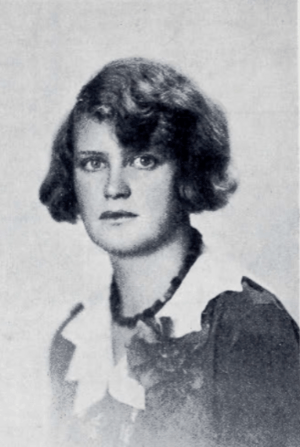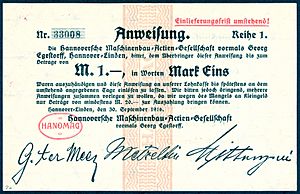Ilse Knott-ter Meer facts for kids
Quick facts for kids
Ilse Knott-ter Meer
|
|
|---|---|
 |
|
| Born | 14 October 1899 |
| Died | 3 November 1996 (aged 97) Rottach-Egern
|
| Nationality | Germany |
| Occupation | Engineer |
| Children | 2 sons (b. 1932 and 1935) |
| Parent(s) | Paula ter Meer (née Behrens) (mother), Gustav ter Meer (father) |
Ilse Knott-ter Meer was a pioneering German engineer. Born Ilse ter Meer on October 14, 1899, she became one of the very first women in Germany to earn a degree in mechanical engineering. She lived until November 3, 1996, leaving behind a legacy of breaking barriers for women in science and technology.
Contents
Early Life and Inspiration
Ilse ter Meer was born in Hanover, Germany. Her father, Gustav ter Meer, was an engineer, and her mother was Paula ter Meer. Ilse had two younger siblings, a sister named Anneliese and a brother named Hans.
From a young age, Ilse was fascinated by machines. Her father, who worked with steam engines and cars, encouraged her interest. He even gave her a toy steam engine to play with, sparking her passion for technology.
Education Challenges and Success
Ilse attended the Realgymnasium in Hanover, a secondary school usually only for boys. After finishing school, she decided to study mechanical engineering. This was a very unusual choice for a woman at the time.
From 1919 to 1924, she studied at the Technical University of Hanover and then the Technical University of Munich. Many male students were not happy about having a woman in their classes. They would stomp their feet and whistle to show their disapproval. However, some fellow students also stood up for her and protected her from verbal attacks.
In 1924, Ilse ter Meer successfully completed her mechanical engineering degree. She was one of only two women to do so at the Technical University of Munich that year. She even wrote an article about testing a Hanomag car, likely the Hanomag 2/10 PS, for a well-known engineering newspaper.
A Career of Firsts
In 1925, Ilse married Carl Knott, an electrical engineer, and became known as Ilse Knott-ter Meer. They moved to Aachen, where she opened her own office. She worked on patents for special machines that cleaned wastewater, which her father had developed.
That same year, Ilse Knott-ter Meer made history again. She became the first female member of the Verein Deutscher Ingenieure (VDI), which is the Association of German Engineers. This was a huge step for women in engineering in Germany.
In 1929, she joined the British Women's Engineering Society (WES). This was the only organization for women engineers in the world at that time. The next year, she wrote an article for their journal, The Woman Engineer, about how sanitary engineering helps keep towns and cities healthy. In 1930, she was chosen to represent German women engineers on the WES Council.
During the 1930s, Ilse Knott-ter Meer worked at Siemens & Halske in Berlin. She also became a mother to two sons, born in 1932 and 1935. In 1930, she helped organize the first official meeting for German women engineers in Berlin. Important engineers from Britain and America also attended this meeting, showing a desire to connect women in engineering worldwide.
Even as political changes happened in Germany during the 1930s, Ilse Knott-ter Meer continued her work at Siemens & Halske.
After World War II, in 1950, Ilse Knott-ter Meer was living in Nuremberg. She continued to be active in the engineering world. From 1956, she was part of an advisory group for the VDI that focused on domestic technology, like household appliances. She also managed an office for a US electrical appliance company.
In 1960, she helped start "Frauen im Ingenieurberuf," which is the women's section of the VDI. She also represented Germany at the first International Conference of Women Engineers and Scientists (ICWES) in New York City in 1964. She attended the second conference in 1967 as well. At the VDI, she gave talks about household technology and worked on committees related to managing household tasks efficiently.
Awards and Recognition
Ilse Knott-ter Meer received many honors for her contributions. In 1975, the VDI awarded her their gold medal for being a member for 50 years. Her husband, Carl Knott, also received the award. They were the first married couple to be given this honor.
In 1983, she was given an Honorary Membership by the Women's Engineering Society. This was a special recognition of her long and impactful career.
Later Years and Legacy
Ilse Knott-ter Meer's husband, Carl Knott, passed away in 1987 after 62 years of marriage. In her final years, she lived in Rottach-Egern. Even in her nineties, she stayed curious and kept up with the latest news in electrical engineering and electronics by reading special magazines.
She died in Rottach-Egern on November 3, 1996. Her lasting impact is still remembered today.
Commemoration
- In 1998, a street in Hanover was named Ilse-ter-Meer-Weg (Ilse-ter-Meer Way) in her honor.
- The Ilse Knott-ter Meer Haus (IK Haus), a student housing building at Leibniz University Hanover, is named after her.
- The new main lecture hall (Audimax) at the Technical University of Munich is also named in honor of Ilse Knott-ter Meer.


